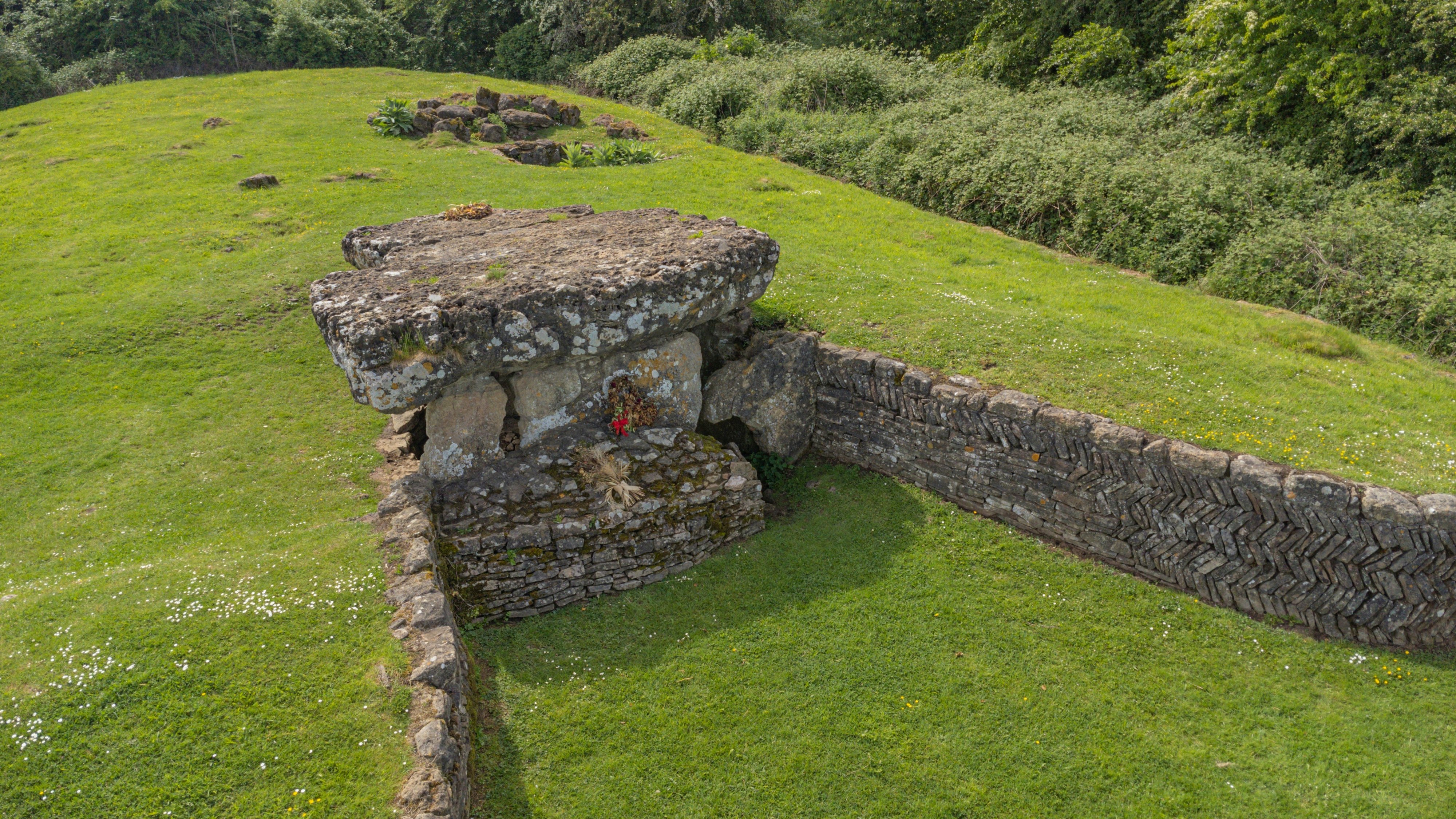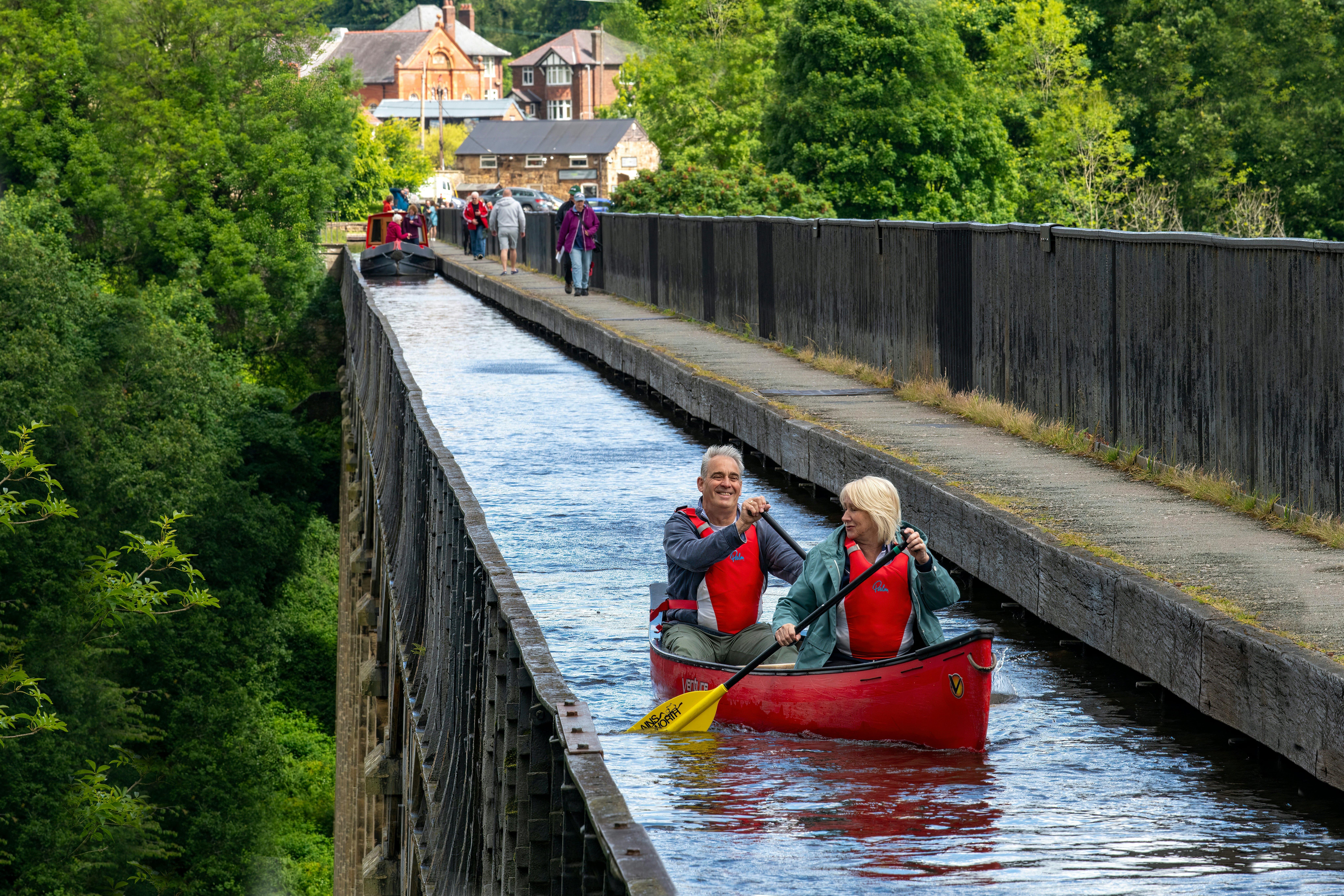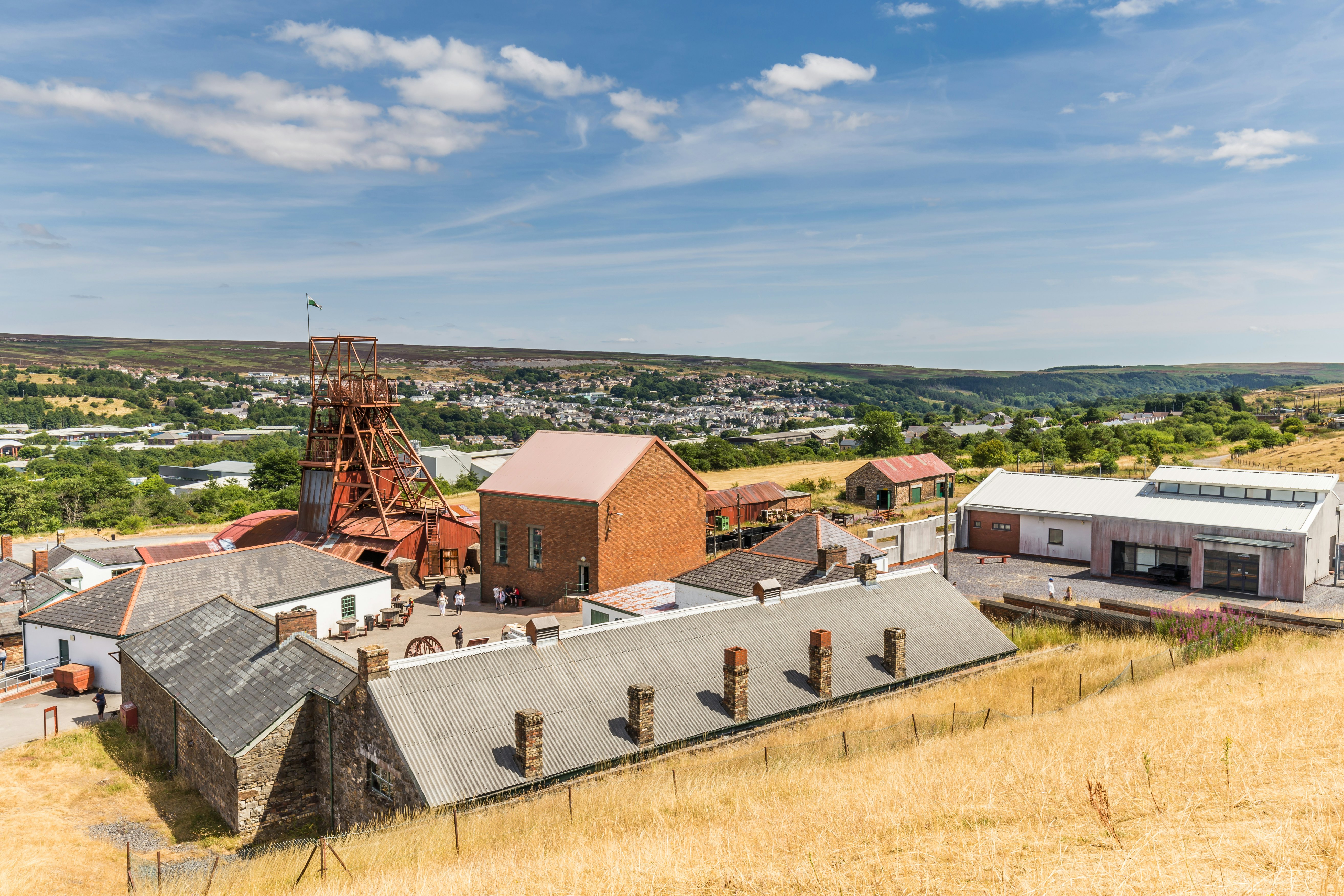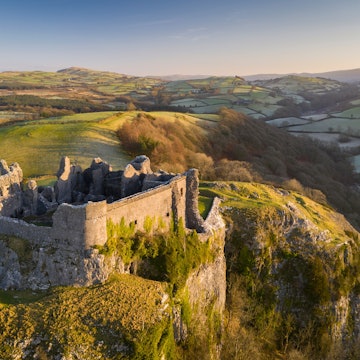

A view of Caerphilly Castle. The best historic sights in Wales span ancient tombs, industrial monuments and castles. Ceri Breeze/Shutterstock
For some visitors, Wales is all about the outdoors, thanks to spectacular national parks such as Snowdonia National Park (Parc Cenedlaethol Eryri), and epic walks such as the hike up Pen-y-Fan and the two-week Pembrokeshire Coast Path. But for others, Wales is all about the history.
This storied land has a heritage that spans at least 10 millennia of seafaring invaders, religious turmoil, medieval feuds, Celtic culture, Iron Age fort builders and ancient Neolithic peoples buried in chambered tombs on lonely headlands. Then there’s the legendary King Arthur – who may or may not have existed in real life, but is indelibly linked to Welsh folklore.
Castles stud the landscape, most thrown up during the centuries of conflict between Welsh dynasties and the Lords of the Marches, the English feudal rulers across the border in Herefordshire and Shropshire. These stand near the ruins of myriad Iron Age hill forts, hinting at an ancient past that is tantalizingly mysterious and unknown.
If you fancy a holiday steeped in history, plan your trip to Wales around the following top historical sights.

1. Tinkinswood Burial Chamber, near Cardiff
Best for prehistoric mystery
Ancient stone dolmens and stone-capped chambered tombs dot the Welsh landscape, crowning coastal headlands and inland hills and mountains – and hinting at an ancient culture that placed great importance on transforming the graves of deceased heroes into monumental markers.
Located near Cardiff, the Neolithic burial chamber of Tinkinswood dates back roughly to 6000–3000 BCE. A collection of enormous stones forms the chamber, which is topped with one of the largest capstones in Britain, weighing around 40 tonnes (44 tons) and measuring 7m (23ft) in length. Excavations here have uncovered bones belonging to at least 50 individuals, alongside stone tools and Neolithic and Bell Beaker pottery.
Historians believe that the burial site was used by communities as late as 2000 BCE (during the early Bronze Age) before it was abandoned. Along with other nearby Neolithic and Bronze Age monuments, Tinkinswood suggests that the pagan burials of ancient Wales were communal, ceremonial and ritualistic.
Other top tombs in Wales: Other important Neolithic graves to seek out include Carreg Coetan Arthur near Newport, a burial chamber supposedly formed when King Arthur threw stones across the landscape; and 5500-year-old Pentre Ifan, Wales’ largest megalithic tomb, in the history-drenched Preseli Hills. Its huge, 5m-long (16½ft-long) capstone balances on three upright stones made of the same bluestone used for the menhirs at Stonehenge.
2. Caerleon Roman Fortress & Baths
Best for military history
On the outskirts of Newport, Caerleon had huge significance to the Roman conquerors who seized control of Britain during the first century CE. Known by Romans as “Isca Augusta,” Caerleon fortress was established in approximately 75 CE as a base for the troops of the Legio II Augusta. Its location was highly strategic, enabling the Roman military to control both the local area and multiple land routes into Wales.
This is the only Roman legionary barracks that can be seen in all of Europe, and artifacts revealing details of Roman life are displayed in the on-site museum, alongside the ruins of a natatio (open-air swimming pool), a Roman garden, and an enormous outdoor amphitheater seating 6000 people (the most complete of its kind in Britain).
More Roman relics in Wales: What did the Romans do for Wales? Quite a lot, based on the ruins that survive. Other good places to see traces of Roman-era Wales include the sections of Roman wall at Cardiff Castle, the Roman-built mine tunnels at Sygun Copper Mine near Llanberis, and the Segontium Roman Fort in Caernarfon, which marked the most westerly point in the Roman Empire.

3. Arthurian Preseli
Best for fans of myth and legend
Wales has more than its fair share of places that claim links to King Arthur, the quasi-mythical 5th-century ruler of ancient Britain, and Merlin, his magician and adviser. Thank the writings of Geoffrey of Monmouth, who laid the foundation stones of Arthurian legend with his writings on British history in the 12th century.
To immerse yourself in the story of King Arthur, the Preseli Hills in Pembrokeshire are marinated in Arthurian folklore. King Arthur’s reputed grave – an understated stone circle known as Bedd Arthur – sits on the lofty Preseli ridge, while the rocky outcrop of Cerrig Marchogion (Rocks of the Knights) reputedly marks the site where some of King Arthur’s knights were turned to stone, following an attack by the monstrous boar Twrch Trwyth.
The bluestones that make up Stonehenge’s inner circle are said to have come from the Preseli Hills, too. Legend has it that Merlin magicked them across the country, but the likelier explanation that the stones were physically hauled more than 150 miles (240km) from Wales to England is no less impressive.
Other King Arthur sites in Wales: Continue the King Arthur quest at Caerleon – said by some to be the location of the real-life Camelot, only with fewer wizards and squarer tables. Over in Snowdonia National Park (Parc Cenedlaethol Eryri), the Llyn Llydaw, Llyn Dinas and Llyn Ogwen lakes all claim to be the spot where the magical sword Excalibur was returned to the Lady of the Lake. The stone cairn atop Yr Wyddfa (Mt Snowdon) is said to have been created by King Arthur to bury a defeated giant.
4. Cardigan Castle, Cardigan
Best for fans of Welsh culture
Perched alongside the River Teifi in Ceredigion, Cardigan Castle stands proud despite numerous conflicts over its millennia-long history. Built in the late 11th century and then rebuilt in 1244, it was the focus for a string of medieval power struggles between the Normans and the Welsh. But its biggest claim to fame is intellectual, not military.
In 1176, the castle hosted the first recorded Eisteddfod, a traditional annual festival of performance, poetry, literature and music. It marked a pivotal moment in Welsh cultural history, establishing a formal platform for the celebration and preservation of Welsh arts and traditions.
Following a multi-million-pound restoration in 2015, the castle has been beautifully revived, with a heritage center, open-air concert facilities (see the website for events), a swish restaurant and groomed, Grade II–listed pleasure gardens.
Planning tip: Combine a castle visit with a stroll among the dunes on nearby Poppit Sands beach, and a walk along the rugged cliffs to the south – the opening section of the two-week Pembrokeshire Coast Path hike.

5. St David’s Cathedral, Pembrokeshire
Best religious site
The UK’s smallest city, St Davids in Pembrokeshire, is the surprising setting for what might be Wales’ most magnificent cathedral. St David’s Cathedral is built on the site of St David’s monastery, which was founded in the 6th century by the man who later became the nation’s patron saint. (He was born nearby, at St Non’s.)
Combining Norman and Gothic architectural styles, intricate stone carvings and a soaring wooden ceiling, St David’s Cathedral is a work of art, as well as an important place of pilgrimage. The 12th-century Pope Callistus II decreed that two pilgrimages to St David’s Cathedral were equivalent to one to Rome, with three equivalent to a pilgrimage to Jerusalem.
This grand monument was built in a hollow and surrounded by high stone walls to deter raiders, but with limited success – the cathedral faced repeated raids by Vikings and later Normans who were set on carting off its treasures.
Planning tip: It’s a short drive to St David’s Head, where you can take in dramatic sea views, investigate traces of an Iron Age fort and Neolithic burial chamber, and visit the dune-backed beach at Whitesands and the cozy Whitesands Beach House cafe.
6. Caernarfon Castle
Best for understanding the English–Welsh rivalry
The magnificent castle in Caernarfon is worth a visit for its dramatic, waterside location (like King’s Landing from Game of Thrones in real life) and its important role in Welsh history. Disputes between Wales’ native princes and the English monarchy caused great tension during the 13th century, leading Edward I to construct Caernarfon Castle as part of his “iron ring” of fortresses to suppress the Welsh resistance.
With its polygonal towers and color-banded stone walls, the fortress is a monumental and dramatic remnant of Edward I’s intolerant reign. Along with Edward I’s castles in Beaumaris, Conwy and Harlech, Caernarfon is recognized as a UNESCO World Heritage Site for its history and design, which combines tall, concentric walls with arrow-slit windows and a highly defensible coastal location, surrounded on two sides by water.
Among other moves to undermine Welsh independence and identity, Edward I installed his son, Edward of Caernarfon, as Prince of Wales – a title still applied to heirs to the crown of Great Britain today.

8. Pembroke Castle, Pembroke
Best for royal history
Poised on a rocky outcrop, Pembroke Castle is the pride of Pembrokeshire, and a relic of Wales’ long history of conquest and counter-conquest. Rising above the Mill Pond on the Pembroke River, the castle has undergone numerous redevelopments since its Norman beginnings in 1093 CE. It’s also the only castle in Britain to be built over a natural cavern.
In the 12th and 13th centuries, the addition of heavy defensive structures and residential buildings fit for royalty elevated the castle into an engine of Welsh medieval military might. Beyond Wales, Pembroke Castle is perhaps best known for being the birthplace of Henry VII (Henry Tudor) in 1457. He later became the only Welsh king of England (after defeating Richard III at the Battle of Bosworth) and the first Tudor monarch.
Planning tip: As well as its castle, Pembroke is worth visiting to walk sections of the Pembrokeshire Coast Path, which runs north and south from the town. For gorgeous coastal scenery, head southwest toward the Angle Peninsula and the long beach at Freshwater West.
9. Cardiff Castle, Cardiff
Best for photo ops
Positioned right in the middle of Cardiff city center, the dramatic fortress of Cardiff Castle has been a strategic lynchpin since Roman times. Starting life as a barracks for legionaries, the fort was upgraded to a motte-and-bailey castle by the Normans, and then transformed into a grand Victorian Gothic residence from the late 1800s to the early 1900s.
The most colorful parts of the castle are the residential quarters, created during the 1500s for the resident earls, who wanted to move away from military austerity and toward livable luxury. But the present lavish decor was the brainchild of the 3rd Marquess of Bute, who teamed up with the architect William Burges in 1865. Drawing inspiration from different movements, styles and cultures, their collaboration resulted in the unashamedly elaborate, gaudy, maximalist decor you see today.
The castle became a symbol of the establishment of Cardiff as the official capital city of Wales in 1955. Gifted with its grounds to the city by the Bute family in 1947 – only eight years before Cardiff gained capital status – it’s a metaphor for the city’s rich history and innovative spirit.
Planning tip: Get more context on the city and the nation at the all-encompassing, free-to-visit National Museum Cardiff. Most of the ground floor is dedicated to the ”Evolution of Wales“ exhibition – a fascinating walk through 4600 million years of Welsh history, with interactive displays, artifacts and images to illustrate how Wales came to be.

10. Pontcysyllte Aqueduct, Vale of Llangollen
Best piece of Welsh engineering
An engineering marvel and a monument to the ingenuity of Welsh engineers, the Pontcysyllte Aqueduct runs for 307m (1007ft) across the River Dee Valley, rising 38m (125ft) above a gorgeous green landscape. It’s the highest canal aqueduct ever built – something you’ll quickly appreciate if you traverse its waters by canal boat or kayak.
Completed in 1805 and designed by Thomas Telford and William Jessop, this groundbreaking aqueduct consists of an iron trough that carries the Llangollen canal across the top of 18 stone arches. Its creation was a critical development in the expansion of the Industrial Revolution, facilitating the transport of raw materials between North Wales and the Midlands in England.
Planning tip: Local operator Ty Nant Outdoors rents out canoes and kayaks for trips across the thin channel of the Pontcysyllte Aqueduct.
11. Caerphilly Castle, Caerphilly
Best for a sense of scale
There’s more to the Welsh town of Caerphilly than its famous cheese. With its riot of grand towers and duck-filled lake, Wales’ biggest castle is like a fortress from a fantasy film made real. Indeed, it has starred in many films about duelling knights (as well as numerous Doctor Who episodes – but its original purpose was strictly strategic.
The expansionist marcher lord Gilbert de Clare constructed the castle in 1268 to flaunt his power in the face of Llywelyn ap Gruffudd, Prince of Wales. Set on a moated island, it’s an evocative ruin today, but its robust battlements give a hint of its former strength. The on-site museum catapults you through the history, but the castle’s most memorable feature is its leaning southeast tower, which looks as though it will topple over with the faintest puff of wind.
Planning tip: On the last weekend in August, the castle grounds host fun and games, fireworks and cheese tasting – dominated by crumbly, creamy Caerphilly, of course – at the Big Cheese festival.

12. Big Pit National Coal Museum
Best for insights into industrial history
One of Wales’ most interesting national museums, the Big Pit National Coal Museum in Blaenavon is a former working coal mine that was transformed into a tribute to Wales’ long history of mining. A visit here will introduce you to the hard lives of Welsh coal miners, and the strong sense of community that bound mining towns and villages together.
Between 1880 and 1980, Blaenavon was an important South Wales colliery that employed hundreds of workers, generating money, supporting livelihoods and providing the country with energy. But the coal mines became uneconomical in the face of cheaper imports, and after the withdrawal of government support, mining went into heavy decline. The last deep mine closed in 2008.
Miners endured extremely challenging conditions 90m (195ft) underground, using hand tools and noisy machines to extract coal, working all day in the stagnant, dust-filled tunnels. A museum since 1983, the museum shows the reality of what mining was like on an underground tour, adding context on the lives of the miners through interactive exhibits. The museum is also part of the Blaenavon Industrial Landscape, a UNESCO World Heritage Site.
Planning tip: If you choose to head underground, you'll be decked out in a hard hat, power pack and other safety gear weighing some 5kg (11lbs), and you won't be allowed to bring matches or anything electrical (including photo equipment and watches) down with you. It’s cold down here, so wear extra layers and sturdy shoes. Children must be at least 1m (3ft3in) tall; visitors with disabilities can arrange tours in advance.
This article was adapted from Lonely Planet’s Wales guidebook, published in June 2025.
















